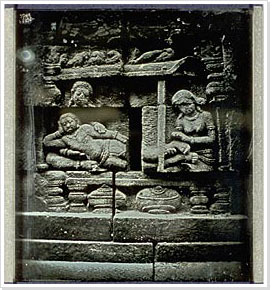Pioneer photography from the Dutch Indies > Daguerreotype
 Frenchman Louis Jacques Mandé Daguerre had developed a method for capturing reflections of light directly from nature on a photosensitive plate. He named this invention 'daguerreotype'.
Frenchman Louis Jacques Mandé Daguerre had developed a method for capturing reflections of light directly from nature on a photosensitive plate. He named this invention 'daguerreotype'.
Exposure times were very long in those days, taking between fifteen minutes and half an hour until 1840. After 1840, exposure times were shortened to half a minute to a minute-and-a-half. Exposure times were also dependent on a large number of other factors: the season, the time of day, interior or exterior photography, camera size, type of lens, and the material's level of photosensitivity.
What is extraordinary about the daguerreotype is the absence of an intermediary step from negative to positive image. The exposures are negatives, but are viewed in positive by mirroring them against a dark background. The image cannot be reproduced, so every daguerreotype is by definition unique.
The daguerreotype was in use from 1839 until around 1860.
